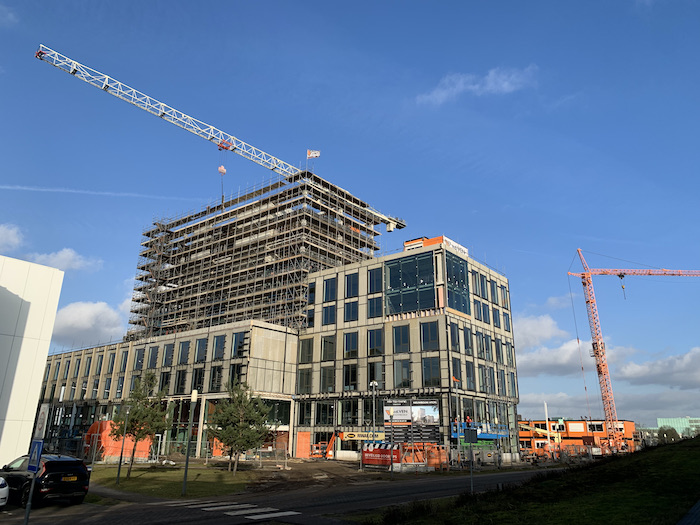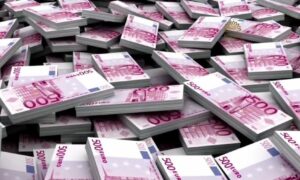(Editor’s note: The Eindhoven Business briefing is part of our Tech Tuesdays series. Dispatches covers tech because so many of our highly skilled internationals are engineers and entrepreneurs.)
For the past seven years, we’ve been watching Eindhoven transform from a company town built around fast-fading Philips to a boom town transformed by the amazing success of Philips spinouts ASML and NXP as well as VDL and High Tech Campus Eindhoven.

In the past year, we’ve realized we’re living in a Boom Town similar to (sort of) Atlanta in 1990, when that city’s metropolitan statistical area – powered by cheap land, huge job growth, low taxes, good universities and a gigantic airport – started growing by an annualized rate of 4.8 percent, going from 2.2 million in population to 6.2 million now. Four-percent growth doesn’t sound that amazing, but for a First World city where birth rates are stagnant or dropping, that kind of prolonged growth defines a Boom Town and is difficult to absorb. In the U.S., that kind of growth is typical, with Phoenix, Austin and other Boom Towns seeing 12 percent-plus annualized population growth since 2000.
By comparison, Eindhoven is growing at just under 1 percent per year, with a peak in 2022. Unlike Atlanta and American Boom Towns, Eindhoven is unlikely to ever reach the 4-percent growth mark, constrained by tough regulations on new construction and an already dense population. Still, even this relatively slow growth rate is problematic because it takes so long to add housing.
For example, Nieuw Bergen is a New Urbanist development on the edge of Eindhoven’s centrum. Dispatches first wrote about it way back in 2017. Only now, in early 2024, is it actually under construction. Nieuw Bergen will add seven buildings and 240 new homes. That’s about what a Houston, a Raleigh or a Phoenix adds every 24 hours.
The Technical University of Eindhoven’s Cursor post from last March on the housing shortage, “Where’s the limit to Eindhoven’s growth?,” states that out of the 10 biggest municipalities in the country, Eindhoven’s number of inhabitants increased the most in 2022. In the post, Mieke Verhees, Eindhoven’s alderperson for housing, districts, space and services, notes the average construction project takes 10 years, with most of this time spent on the zoning and approval phase.
The good news is construction is accelerating from Strijp-S to the far edges of the city such as Heeze. The centrum is getting a 25 million euro refresh. High Tech Campus has the first of seven new buildings nearly finished.
All good, right? Well, there are still challenges. And the bottom line is, population density is crucial to innovation centers. More people equals more talent.
Palantir CEO Alex Karp: U.S. eating everyone’s lunch on AI
Eindhoven wins because its diversified economy produces the most advanced technology and has the most valuable tech company in Europe in ASML. But the last thing anyone wants is for Eindhoven to become a one-trick pony, over-reliant on the fortunes of one company.
That’s why an increasingly important sector here is artificial intelligence. Not everyone is betting on Eindhoven, the Netherlands or Europe.
Stop us if you’ve heard this: Within 10 years, 95 percent of the world’s top tech companies will be American thanks to the U.S. lead in AI, according to Alex Karp. (They’re already about 70 percent, with Europeans accounting only 11 out of the world’s Top 100 ranked by market cap.)
If you ask Karp, CEO of the massive global data company Palantir, the United States has already won the AI wars. And that’s not all he had to say at the Economic Forum in Davos last month. You can talk all you want about Dutch directness, but Karp was brutally frank about the European AI startup ecosystem – it sucks. He told Axios that only American companies are doing anything worthwhile. “Any one of the products we built would be the number one startup in Germany — and we have five,” according to the Axios post.
The post notes that Karp is not anti-Europe. He attended graduate school in Germany and speaks French. Rather, he says he’s “pro-West,” and that Europe is letting the West down by not realizing its tech potential. Part of that, he says, is because there’s not the same “religious” fervor here as in the U.S. to build companies and, by extension, the personal wealth of founders.
In other words, “greed – for lack of a better term – is good.”
Our own worst enemy?
Hating Europe is a full-time obsession for the MAGA set in the U.S., who are repulsed by our higher quality of life and social safety nets and basically lie about high unemployment and other issues.
The New York Times’ Nobel Prize-winning economist and columnist Paul Krugman sets the record straight, writing recently that “Europe is in astonishingly good shape, economically and socially, compared with almost any other part of the world.” It’s just different than the U.S. because values are different, Krugman writes in “What’s the Matter with Europe.”
We have a different take: Europe’s wounds are all self-inflicted. The biggest enemy of the innovation ecosystem is real estate investment because high net worth individuals can invest their surplus in housing or whatever and almost be assured of a nice yield. Or at least not losing their capital. So, they’re not going to be throwing money at venture capital firms.
The second biggest enemy is the government, which is all too happy to shut out the anemic private sector risk funding and fund innovation itself.
The instinct is noble, but ultimately self-defeating.
The Dutch House of Representatives is debating the future of the National Growth Fund. The Fund is meant to ensure long-term investments in innovations and future-proof the economy. Via the National Growth Fund, billions in capital are available to invest in new technologies.
The problem is, if the government pours billions into the effort to create quantum computing or whatever, that makes the private sector risk capital even less relevant, if that’s even possible in the Netherlands.
Are government bureaucrats – risk adverse and employed for life – who you want picking the tech winners?
In the U.S., the public sector funded early development of computers and computer chips but did it as a customer, buying up the latest technology to support the space program or weapons programs. Same today, with DARPA and other government agencies funding all sorts of research, but again, as customers. That means at least some accountability.
What Dutch startup teams know is the government isn’t a great steward of taxpayer money, not having the ability to monitor startup progress, or lack of. This takes away the pressure to reach milestones so teams can still take summers off, then return just in time to start planning their fall break, Christmas, Carnival, Easter, spring break and so on.
Teams also know that once the government turns on the funding tap, they can’t turn it off without facing political backlash. Which again erases any sense of urgency.
There are alternatives.
The beauty of the Philips Model that produced ASML and NXP – creating technology such as photolithography inside big corporations, then building teams around it – is that teams have seasoned engineers, product development people and managers. AND board oversight.
In an Innovation Origins post, Bart Brouwers mentions the Asia approach. And yes, Taiwan provided 48 percent of the startup capital for TSMC, now the largest chip maker in the world. But the government funded Morris Chang, a semiconductor legend who had a proven track record at Intel, and Philips also funded TSMC.

‘Europe’s startup hub’ … and it’s not Eindhoven
The Christian Science Monitor has a detailed story about “Europe’s startup hub,” but it’s not about Eindhoven. It’s about Amsterdam, and it’s got some fascinating data to back up that moniker. In the post, Amsterdam sounds a lot more like Singapore than the Netherlands.
In “How the Netherlands became Europe’s startup hub,” reporter Lenora Chu has a list of why Amsterdam is cranking out successful startups that actually have, you know, exits:
• Scale. Amsterdam has a pop of 900,000 people, with 65 percent of all venture-backed startups in western and northern Europe. (The population of Amsterdam and the rest of the Randstad metropolitan cluster is closer to 8 million.)
• LOTS of capital
• Top universities, including the University of Amsterdam
• A go-for-it, entrepreneurial attitude that doesn’t stigmatize failure
• A lack of bureaucracy
• A mentality that’s more comfortable with ambition and wealth accumulation
The post is framed around the rise and fall of the VanMoof electric bicycle company that was hailed as the “Tesla of bikes” until it wasn’t. But the fact that VanMoof happened at all shows that Amsterdam is a great laboratory for creative startup ideas, according to the post.

(Photo by Terry Boyd for Dispatches)
Quick Hits:
• Europe’s goal is to reach 20 percent of the chip market is “totally unrealistic,” according to guys who know. ASML’s outgoing CEO Peter Wennink says the 43 billion euro Chips Act is not enough to move Europe off the 8-percent market share it has now. Kurt Sievers, CEO of NXP, has gone on the record saying, “We have calculated that we would need 500 billion euro investment in Europe to reach the 20 percent market-share goal.” To reach that 20 percent market share would require building a dozen new fabs by 2030 at an average cost of about 40 billion euros per plant.
• High Tech Campus Eindhoven officials just announced their first tenant for the nearly complete Lucis One Building on the south side of campus. Molex, based in Chicago, makes high tech electronics and switches. It’s moving its operations from Eindhoven Airport and taking the entire first floor of the 11-story office building, expected to open later this year.
• Philips is still on the ropes, ending sales of its flawed sleep apnea devices in the U.S. after tangling with the Food and Drug Administration. The agreement with the FDA to pull out of the market follows the recall of millions of breathing devices and ventilators due to concerns that foam used to reduce noise could degrade, is carcinogenic and can get into the air stream.














